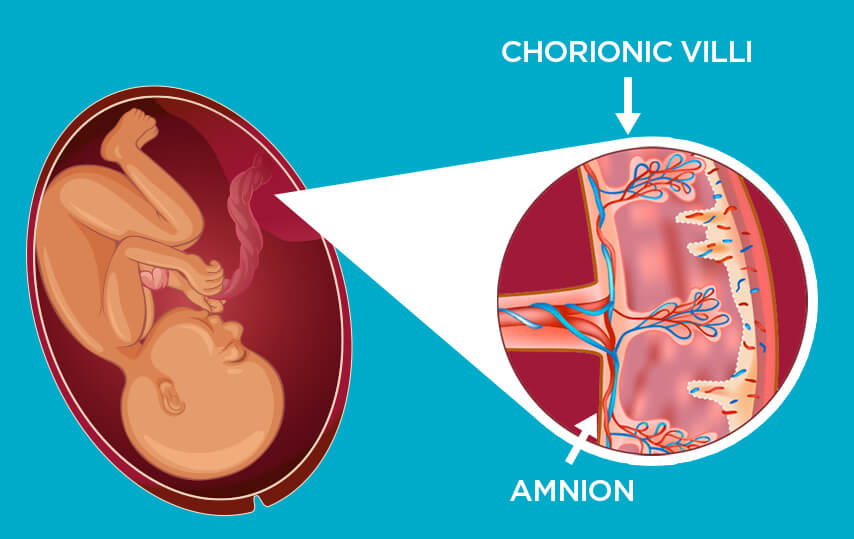What is Placenta Tissue Banking?
Unlocking the Full Potential of Your Baby’s Placenta
Did you know the placenta holds a gift for you, too?
While the amnion and chorionic villi are for your baby, the maternal part of the placenta – the decidua – is a rich source of your own perfectly matched stem cells. Discover how Maternal Decidua Banking offers a once-in-a-lifetime opportunity to invest in your future well-being too.
During pregnancy, your placenta is essential, nourishing your baby as they grow. But its incredible usefulness doesn’t have to end at birth.
Your placenta contains a wealth of powerful cells for both you and your baby, containing unique cells for your child in the amniotic membrane (amnion) and chorionic villi, and a rich source of your own matched stem cells from the maternal decidua. The decision for placenta tissue banking allows you to preserve these unique cells.
These placental tissues are already being used in therapies to push the boundaries of medicine – helping to heal serious burns, diabetic ulcers, and regenerate damaged tissues. Furthermore, they are the focus of a rapidly growing body of promising clinical trials for conditions like cardiovascular diseases, brain injuries, arthritis, and more.
By choosing placenta tissue banking with Cells4Life, you can ensure your child has access to a wider spectrum of the latest regenerative therapies as they become available.
Placenta Tissue Banking with Cord Blood and Tissue
Cells4Life is at the forefront of providing comprehensive newborn stem cell banking options. We offer placenta tissue banking in conjunction with cord blood and tissue banking, allowing you to maximize the types and quantities of stem cells preserved for your baby’s future, significantly broadening their therapeutic possibilities.
Storing your placenta’s valuable tissues after birth is a straightforward process with Cells4Life. You can choose to bank placental cells from the chorionic villi, the amniotic membrane, and the decidua alongside traditional cord blood and tissue banking.

Placenta Tissue Banking
with Cells4Life
Your placenta offers two unique components for your baby’s placenta tissue banking: the inner amniotic membrane (amnion) and the chorion’s remarkable chorionic villi. Both boast powerful regenerative properties and are actively being studied in global clinical trials.

Cells4Life is proud to be the only private bank in the USA offering families the distinct opportunity to preserve both these vital placental tissues—the amnion and the chorionic villi—separately.
This pioneering approach helps your family unlock their full, exciting potential:
Amnion Banking: Preserve the amniotic membrane from your placenta. This resilient tissue has a century-long history of aiding healing in burns and wounds and now shows promise in clinical trials for conditions like heart disease, MS, eye diseases, and more.
Placental Banking (Chorionic Villi): Secure the potent cells from your placenta’s chorionic villi. These villi are rich in unique regenerative cells, like MSCs, currently vital in clinical trials for arthritis, cerebral palsy, diabetic ulcers, and beyond.
As part of our unique US service, each of these tissues is meticulously processed and stored individually, maximizing future therapeutic options.
GET YOUR FREE INFO KIT
The Benefits of Placenta Tissue Banking
Choosing placenta tissue banking offers your family access to a wide array of current and potential future benefits:
Access to Proven and Emerging Therapies
The power of placental tissues is already being realized. The amniotic membrane has a century-long history in treating wounds, burns, and eye conditions. Today, both amnion and cells from the chorionic villi are at the cutting edge of regenerative medicine research. Storing these tissues is not just an investment in future therapies; some applications are already improving lives.
More Cell Types, More Treatment Avenues
The more types and quantities of stem cells your child has stored, the better. By adding placenta tissue banking (Amnion and Placental Cells from chorionic villi) to your baby’s umbilical cord blood and cord tissue storage, you maximize the diversity of cells available, ensuring they can benefit from the widest possible range of therapeutic options as medical science advances.
Amnion: Effective Now, Innovating for Tomorrow’s Treatments
The amniotic membrane is at the forefront of exciting medical research. Not only are there several existing therapies using amnion, clinical trials are actively exploring its potential to treat and manage a variety of challenging health conditions, including:
Ulcers
In 2017, research showed that the amniotic membrane promotes ‘epithelialization’—the body’s process of replacing skin cells to heal a wound. Other studies also indicate that amnion tissue is beneficial in healing diabetic foot ulcers, a serious complication affecting many individuals with diabetes.
Lung & Liver Fibrosis
The powerful anti-inflammatory effects of the amniotic membrane may make it an ideal therapeutic option for conditions like liver fibrosis. In animal studies, applying amnion has led to tissue regeneration, inhibited fibrosis (the scarring of connective tissue), and reduced inflammation.
Cardiovascular Conditions
Studies suggest that injections of cells derived from or cultured with amnion could be used to address cardiovascular defects. Additionally, patches of the amniotic membrane itself have been applied to treat patients with inflammatory cardiovascular conditions.
3D Bioprinting of Tissues
3D bioprinting is a cutting-edge technology, and scientists are now exploring its potential to create biological tissues. Researchers have utilized stem cells associated with the amniotic membrane to help bio-engineer functional muscles, jawbone fragments, and even ear cartilage.
Dry Eye
The amniotic membrane is also used to treat more common conditions. For instance, doctors have used it to enhance recovery in patients with severe dry eye, observing improvement in 88% of cases in one study involving 90 patients.
Brain Injury
A growing body of research suggests that cells from the placenta, including those from or supported by the amniotic membrane, could aid in recovery from acute brain injury. This may occur by reprogramming inflammatory responses and promoting lasting improvements in neurological function.
Amnion Skin Grafts
The amniotic membrane is rich in cytokines and growth factors, enabling it to support wound healing and reduce scar tissue formation. It is also believed to alleviate pain when applied to a wound. Because it is non-immunogenic (unlikely to cause an immune response), it’s ideal for allogeneic use (from a donor to a recipient) as the risk of immune system rejection is low.
Burns
A 2016 study concluded that using the amniotic membrane as a dressing for burn wounds can reduce pain and lead to faster healing.
Type 2 Diabetes
The amniotic membrane shows promise as an effective therapy for conditions impacting millions of people globally. For example, a 2016 study indicated that an injection of cells derived from amniotic placental tissue may help improve glycemic control in patients with diabetes.
Placental Cells: Pioneering Future Medical Treatments
Scientists are continually uncovering the vast potential of chorionic villi. These cells show incredible promise in a rapidly expanding list of therapeutic applications, with ongoing research highlighting their potential for various conditions:
Heart Disease
Heart disease is a major health concern worldwide. Cells from prenatal sources, particularly chorionic villi, show significant potential in cardiovascular tissue engineering. Scientists anticipate they could be used to help create heart valves and potentially even new blood vessels.
Crohn’s Disease
Crohn’s disease is a challenging inflammatory condition. Preclinical studies indicate that cells from chorionic villi may help reduce liver inflammation, a common symptom associated with Crohn’s.
Osteoarthritis
Osteoarthritis impacts the quality of life for many individuals. International research includes studies where chorionic villi-derived cells have been injected into arthritic knees to determine if they can reduce inflammation, stiffness, pain, and improve movement
Type 2 diabetes is a widespread health issue. Clinical trials have explored using cells from chorionic villi for this condition. In one such study, after receiving these placental cells, some patients with Type 2 diabetes showed increased insulin levels, with a notable portion (4 out of 10 in that study) reducing their insulin dosage by over 50%.
Ischemic Stroke
Stroke is a serious medical event affecting many. Animal studies suggest that chorionic villi cells could aid in recovery for stroke patients, particularly due to their potential to promote neural growth and repair in affected brain areas.
Quick questions…
What happens to the placenta after birth?
In most cases, your placenta is discarded after birth and a potentially life-changing resource simply goes to waste. When you choose to store your placenta after birth, your placenta is collected and sent to our laboratory for processing and storage.
How does the placenta tissue banking collection process work?
The collection for placenta tissue banking happens after the third stage of labor, when the placenta has been delivered and the umbilical cord has been cut. First, cord blood and cord tissue collection is performed, if you’ve booked that service. Then, the placenta is stored inside a biopouch and placed into the kit box to be sent back to our laboratory for processing and storage. The whole process happens in a separate room, and will not interfere with the precious first bonding moments between you and your baby.
How much does placenta tissue banking cost?
The price of placenta tissue banking varies according to which service you choose. Storing just placental cells OR amnion alone starts at $850, while storing placenta AND amnion starts at $1,695. You can also choose to store your placenta alongside umbilical cord blood and cord tissue with our VIP bundle. You can find out more about your options on our pricing page.
Is placenta tissue banking compatible with placenta encapsulation?
Placenta encapsulation is the process of dehydrating and grinding the placenta before packaging the resulting powder into pills. The process is a form of placentophagy, which is the act of consuming the placenta after birth.
Encapsulation is not compatible with placenta tissue banking, so you would need to make a decision between the two options. However, should you choose encapsulation, you will still be able to retain stem cells from cord blood and cord tissue.
Is placenta tissue banking compatible with delayed cord clamping?
Yes, placenta tissue banking is fully compatible with delayed and optimal cord clamping. Collection takes place in a separate room after the third stage of labour and clamping of the cord.

